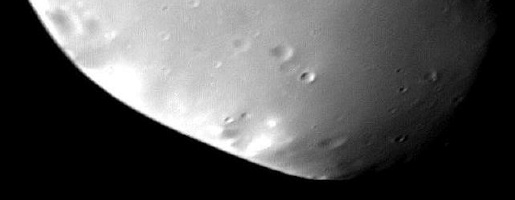 |
|||
|
Viking
2 Orbiter view of the northern portion of Deimos from 500 kilometres
|
|||
| DEIMOS - MOON OF MARS | |||
| Deimos is the outermost and smallest of the two Martian moons (Phobos is the inner moon). The Greek author Hesiod, writing the Theogeny in 800BC, stated that Deimos is one of the sons of Ares (Mars). Deimos (like Phobos) is another Greek word for fear. In the Illiad, Deimos accompanies Phobos, so the naming of this small moon is appropriate. Very little is known about Deimos - there are only a few pictures of its surface, and there are no plans for spacecraft to visit. | |||
| Moving away from Mars | |||
| Deimos orbits at an average distance of 23,459 kilometres, and travels around Mars at an average velocity of 1.36 kilometres per second, taking 1.26 days to complete one orbit. The size of Deimos' orbit is slowly increasing - Deimos is moving away from Mars. Deimos, in common with many other moons, is tidally locked to its parent planet. That is, the same face of Deimos always points towards Mars - synchronous rotation. | |||
| An irregular shape | |||
| Deimos is typical of the very small moons in the Solar System. It is irregularly shaped, about 10 kilometres in its longest dimension and about 8 kilometres across at its widest part. Deimos is in fact the smallest moon in the Solar System. | |||
| Deimos, as expected, has a low mass, 1.9 x 1015kg, lower than many of the moons of the outer planets. The density of Deimos is also low - lower than that of the asteroids. | |||
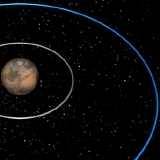 The orbit of Deimos. |
 The irregular shape of Deimos, the Solar System's smallest moon. |
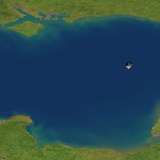 Comparison between Deimos and Earth. |
|
| An icy interior? | |||
| There is no information concerning the interior of Deimos, but knowing the density and surface characteristics, it is likely to be similar to carbon-rich meteorites. Although there is no evidence of water, a water-ice interior cannot be ruled out. | |||
| Magnetic field | |||
| No magnetic field has been detected. This is to be expected, as the low mass and density of Deimos rules out a metal core capable of generating a magnetic field. | |||
| No atmosphere | |||
| No atmosphere has been detected. One of the high resolution images of Deimos shows faint wind streaks across the surface. This does not indicate an atmosphere - the wind was probably very temporary and caused by an impacting meteoroid. Deimos lacks the gravity to keep an atmosphere. | |||
| Surface | |||
| Deimos is a dark moon, reflecting only 6% of the sunlight falling on it. This low albedo is typical of C-type asteroids. | |||
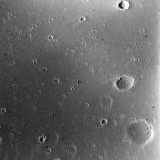 Viking 2 Orbiter view of craters and wind-streaks. |
 Viking 2 Orbiter view of the powdery surface of Deimos |
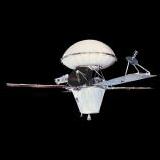 Viking Orbiter spacecraft. |
|
| The surface of Deimos is cratered, but the craters are subdued, looking as though they are covered in a layer of dust. During the formation of a Deimos impact crater, dust will easily be thrown off Deimos due to the low gravity and low escape velocity. However, such ejected dust remains trapped in orbit around Mars, as it has not escaped the stronger Martian gravity. Eventually the dust falls slowly back onto the surface of Deimos - over millions of years the dust forms a layer covering the small moon. The dust layer on Deimos may be up to 50 metres deep. Dust clouds in orbit have been detected amongst Jupiter's moon system. | |||
| High resolution images of Deimos were obtained by the Viking 2 Orbiter spacecraft. The spacecraft orbit was adjusted so that it would be in a resonant orbit with Deimos, thereby enabling the spacecraft to approach the moon to within only 30 kilometres. The resultant images show features as small as 3 metres across. Larger boulders and blocks of rock the size of houses can also be seen. Also visible are craters that are almost completely submerged in a layer of dust. | |||
| Asteroid beginnings | |||
| Deimos has all the characteristics of an asteroid, suggesting that it originated far beyond the orbit of its current parent, Mars. The geology of Deimos does not match the geology of Mars, meaning that Mars and Deimos did not form in the same place in the Solar System. | |||
| Hubble Space Telescope observations suggest that Deimos is very similar to a group of asteroids currently trapped in Jupiter's orbit - the Trojans. | |||
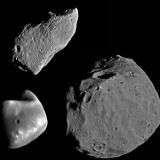 A comparison of images of the other Martian moon Phobos, Deimos, and the asteroid 951 Gaspra demonstrates the similarities between Deimos and asteroids. |
|||
| Discovered in 1877 | |||
| Deimos was discovered on August 10th 1877 by Aseph Hall. and has been the target of only one spacecraft mission, Viking 2. | |||
 At a distance the surface of Deimos appears smooth as seen by the Viking 2 Orbiter. |
 Viking 2 Orbiter view of the northern portion of Deimos. |
||
|
|
|||